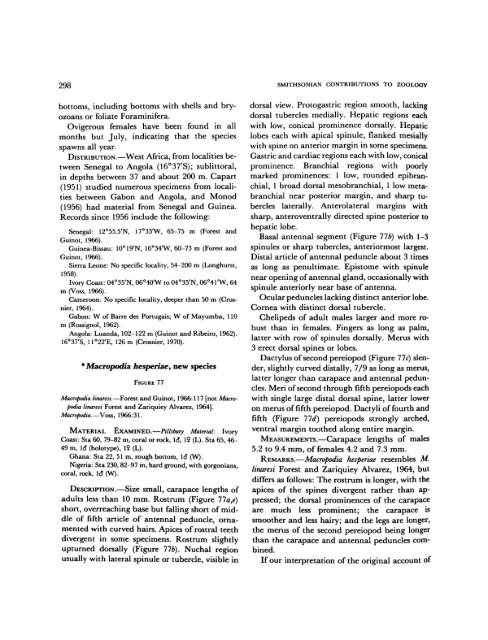West African Brachyuran Crabs - Smithsonian Institution Libraries
West African Brachyuran Crabs - Smithsonian Institution Libraries
West African Brachyuran Crabs - Smithsonian Institution Libraries
Create successful ePaper yourself
Turn your PDF publications into a flip-book with our unique Google optimized e-Paper software.
298<br />
SMITHSONIAN CONTRIBUTIONS TO ZOOLOGY<br />
bottoms, including bottoms with shells and bry- dorsal view. Protogastric region smooth, lacking<br />
ozoans or foliate Foraminifera.<br />
dorsal tubercles medially. Hepatic regions each<br />
Ovigerous females have been found in all with low, conical prominence dorsally. Hepatic<br />
months but July, indicating that the species lobes each with apical spinule, flanked mesially<br />
spawns all year.<br />
with spine on anterior margin in some specimens.<br />
DISTRIBUTION.—<strong>West</strong> Africa, from localities be- Gastric and cardiac regions each with low, conical<br />
tween Senegal to Angola (16°37'S); sublittoral, prominence. Branchial regions with poorly<br />
in depths between 37 and about 200 m. Capart marked prominences: 1 low, rounded epibran-<br />
(1951) studied numerous specimens from localichial, 1 broad dorsal mesobranchial, 1 low metaties<br />
between Gabon and Angola, and Monod branchial near posterior margin, and sharp tu-<br />
(1956) had material from Senegal and Guinea. bercles laterally. Anterolateral margins with<br />
Records since 1956 include the following: sharp, anteroventrally directed spine posterior to<br />
Senegal: 12°55.5'N, 17°33'W, 65-75 m (Forest and<br />
Guinot, 1966).<br />
Guinea-Bissau: 10°19'N, 16°34'W, 60-73 m (Forest and<br />
Guinot, 1966).<br />
hepatic lobe.<br />
Basal antennal segment (Figure lib) with 1-3<br />
spinules or sharp tubercles, anteriormost largest.<br />
Distal article of antennal peduncle about 3 times<br />
Sierra Leone: No specific locality, 54-200 m (Longhurst,<br />
1958).<br />
Ivory Coast: 04°35'N, 06°40'W to 04°35'N, 06°41'W, 64<br />
m (Voss, 1966).<br />
Cameroon: No specific locality, deeper than 50 m (Crosnier,<br />
1964).<br />
as long as penultimate. Epistome with spinule<br />
near opening of antennal gland, occasionally with<br />
spinule anteriorly near base of antenna.<br />
Ocular peduncles lacking distinct anterior lobe.<br />
Cornea with distinct dorsal tubercle.<br />
Gabon: W of Barre des Portugais; W of Mayumba, 110<br />
m (Rossignol, 1962).<br />
Angola: Luanda, 102-122 m (Guinot and Ribeiro, 1962).<br />
16°37'S, 11°22'E, 126 m (Crosnier, 1970).<br />
Chelipeds of adult males larger and more robust<br />
than in females. Fingers as long as palm,<br />
latter with row of spinules dorsally. Merus with<br />
3 erect dorsal spines or lobes.<br />
* Macropodia hesperiae, new species<br />
Dactylus of second pereiopod (Figure lie) slender,<br />
slightly curved distally, 7/9 as long as merus,<br />
FIGURE 77<br />
latter longer than carapace and antennal peduncles.<br />
Meri of second through fifth pereiopods each<br />
Macropodia linaresi.—Forest and Guinot, 1966:117 [not Macrowith<br />
single large distal dorsal spine, latter lower<br />
podia linaresi Forest and Zariquiey Alvarez, 1964].<br />
Macropodia.—Voss, 1966:31.<br />
on merus of fifth pereiopod. Dactyli of fourth and<br />
fifth (Figure lid) pereiopods strongly arched,<br />
MATERIAL EXAMINED.—Pillsbury Material: Ivory<br />
Coast: Sta 60, 79-82 m, coral or rock, 16\ 1$ (L). Sta 65, 46ventral<br />
margin toothed along entire margin.<br />
MEASUREMENTS.—Carapace lengths of males<br />
49 m, 16* (holotype), 1? (L).<br />
Ghana: Sta 22, 51 m, rough bottom, 16* (W).<br />
Nigeria: Sta 230, 82-97 m, hard ground, with gorgonians,<br />
coral, rock, 1(5 (W).<br />
5.2 to 9.4 mm, of females 4.2 and 7.3 mm.<br />
REMARKS.—Macropodia hesperiae resembles M.<br />
linaresi Forest and Zariquiey Alvarez, 1964, but<br />
differs as follows: The rostrum is longer, with the<br />
DESCRIPTION.—Size small, carapace lengths of apices of the spines divergent rather than ap-<br />
adults less than 10 mm. Rostrum (Figure 77a,*) pressed; the dorsal prominences of the carapace<br />
short, overreaching base but falling short of mid- are much less prominent; the carapace is<br />
dle of fifth article of antennal peduncle, orna- smoother and less hairy; and the legs are longer,<br />
mented with curved hairs. Apices of rostral teeth<br />
divergent in some specimens. Rostrum slightly<br />
upturned dorsally (Figure Tib). Nuchal region<br />
usually with lateral spinule or tubercle, visible in<br />
the merus of the second pereiopod being longer<br />
than the carapace and antennal peduncles combined.<br />
If our interpretation of the original account of

















